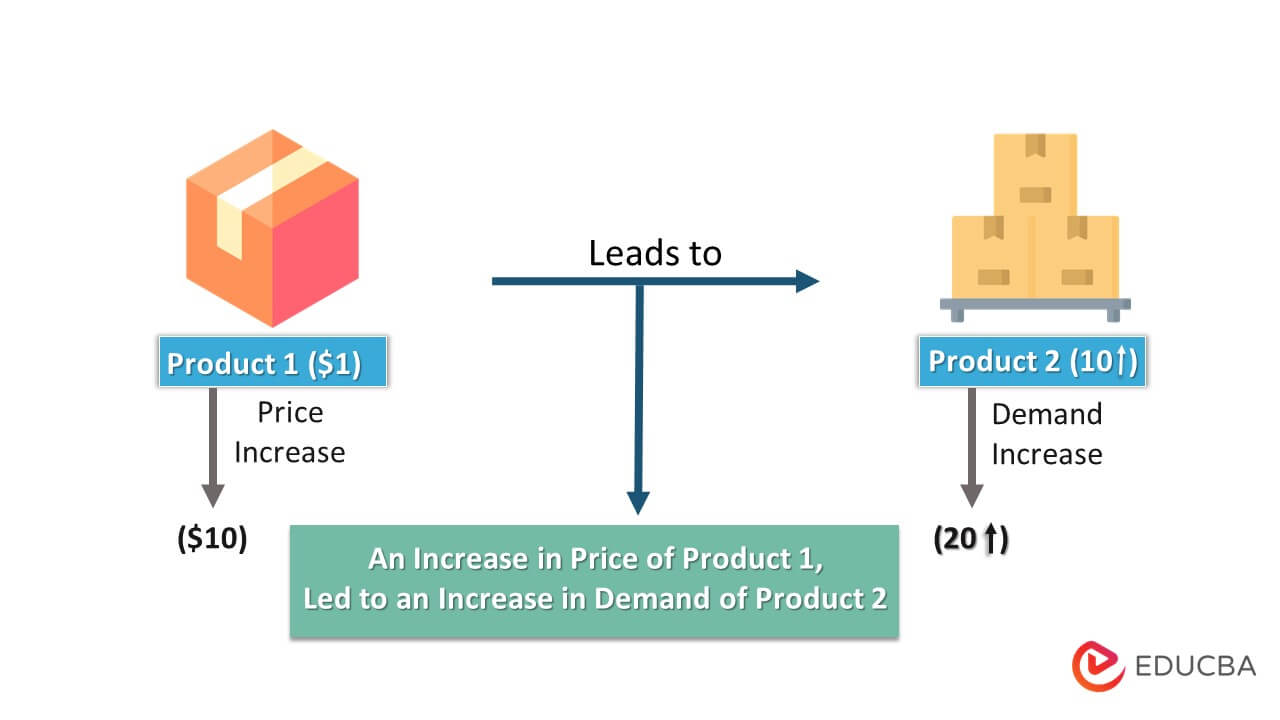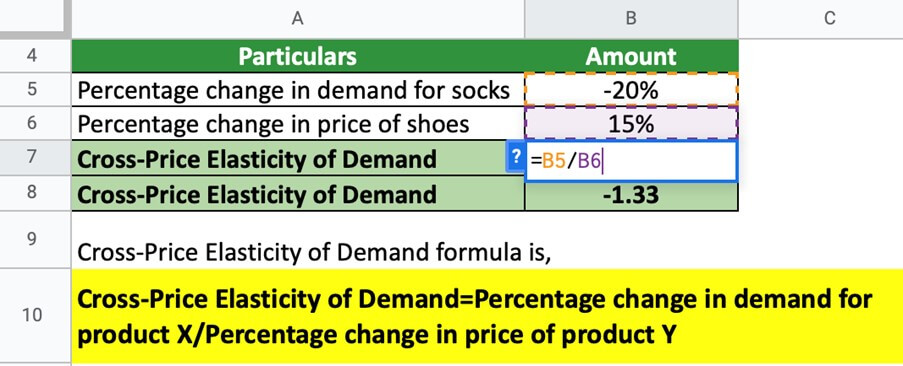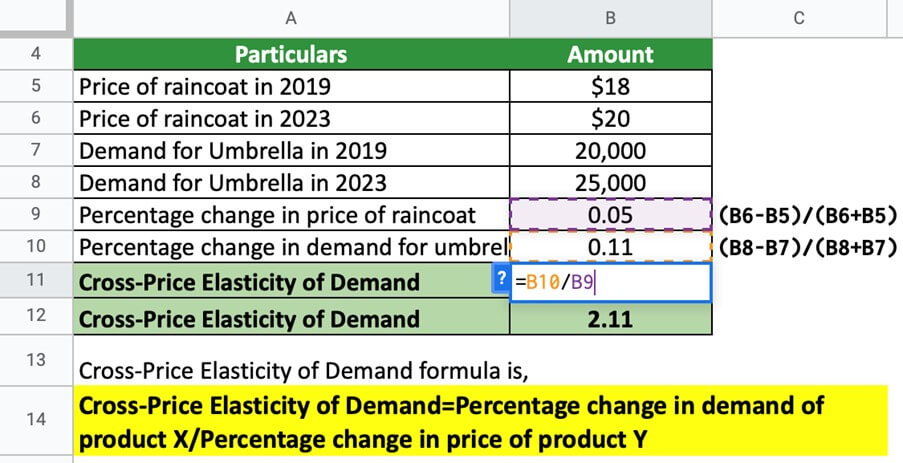Updated July 6, 2023
What is the Cross-Price Elasticity of Demand?
The Cross-Price Elasticity of Demand is the concept that measures how responsive the demand for one product is to a change in the price of another product. For example, a rise in the price of petrol and diesel will see people opting for electric vehicles. Thus, there will be an increase in demand for the same.
Key highlights
- It helps to determine the change in demand for one good because of the change in the price of the other.
- It depicts a relationship between the demand and the pricing of the substances at a consumer level.
- With substitute products, the Cross-Price Elasticity is always positive. With complementary products, the result is negative. The result is zero if the two products have no intersection at all.
- Economists calculate it by dividing the percentage change in demand for product X by the percentage change in the price of product Y.
How Does the Cross-Price Elasticity of Demand Work?
- Different market factors influence the concept of cross-price elasticity. This concept is dependent on the consumers’ behavior in the market.
- The consumers decide whether or not the pricing of a particular product is appropriate.
- Businessmen make necessary changes to the price of a commodity to increase its demand while maintaining a proper margin of profits.
- This tampering with the price of a commodity to generate demand is done with the help of concepts such as Cross-Price Elasticity of Demand.
- By estimating it, businessmen fix the prices of their goods to boost sales. It ensures fair competition for everyone participating.
Cross-Price Elasticity of Demand for Different Products
Substitute Products
- The ratio for substitute products is always positive.
- Let us take the example of rice and wheat. If rice prices increase abruptly, then the demand for rice will naturally decrease. Henceforth, the demand for wheat will increase among consumers as it is a cheaper alternative.
- As the numerators and denominators increase, the ratio will be positive.
Complementary Products
- The ratio for complementary products is always negative.
- For example, tennis balls and tennis rackets go hand-in-hand. The demand for the products is dependent upon each other.
- If the price of a tennis racket increases suddenly, the demand for tennis rackets will decrease in the market. Therefore, the demand for tennis balls will also decrease. So, one of the factors in the ratio will be negative, providing an overall negative result.
Neutral Products
- It is zero for unrelated products.
- Let’s say rice and a tennis ball are entirely unrelated products. In simple terms, they have no intersection between them. Any change in the price of either product will not affect the demand for another, as there is no connection between the two. Both products have different utilities.
- Therefore, the change in the price of rice will not affect the demand for tennis balls in the market.
Formula
Here,
- A percentage change in demand for X divides the difference and sum of new and old demand.
- A percentage change in the price of Y is the division of the difference and sum of the new and old prices.
Examples
Example #1
Officials of AtoZ, a footwear company, decide to increase the price of shoes it produces by 15%. This change in the price of shoes affects the demand for socks which witnesses a fall of 20%. Determine the Cross-Price Elasticity of Demand.
Given,
Solution:
The answer is –1.33. Since it is a negative number, we can conclude that shoes and socks are complementary products.
Example #2
The price of a raincoat in 2019 was $18, whereas the number of umbrellas sold was 20,000 in 2019. The price of raincoats increased to $20 in 2023, and the demand for umbrellas rose from 20,000 to 25,000. Calculate the Cross-Price Elasticity of Demand.
Given,
Solution:
We use this formula to calculate the percentage change,
Let’s calculate the percentage change in demand for umbrellas and the price of raincoats,
Firstly, computing the percentage change in the price of raincoat:
Raincoat (Price) = ($20-$18)/($20+$18) = 0.05
Now, calculating the percentage change in demand for umbrellas:
Umbrella (demand)=(25,000-20,000)/(25,000+20,000) = 0.11
Implementing the final formula,
The Cross-Price Elasticity of Demand is 2.11. Since it is a positive number, we can conclude that umbrellas and raincoats are substitute products.
Advantages and Disadvantages
|
Advantages |
Disadvantages |
| This concept proves that businesses enjoying a monopoly can price their products as they, please. | In a competitive market, businessmen can’t price their products unreasonably high, as it will decrease their demand. |
| It helps in determining the correct price of the product by analyzing demand. | Technicalities of this concept often leave businesses dependent on their competitor’s prices. |
| The goods can be traded at a universally accepted price, ensuring fair competition. | Because of cut-throat competition, businesses constantly need to monitor the actions of their competitors. |
| This principle works very well on related goods. Thus, businesses can draw conclusions using this concept. | This principle fails when we consider unrelated goods for comparison. Businesses fail to analyze the market using this concept. |
Final Thoughts
The idea of Cross-Price Elasticity of Demand is preferable to the brands to strategize their pricing in the market. If used wisely, it can provide a competitive advantage to the business as it depicts the demand pricing relationship at the customers’ level. Despite limitations, it is one of the best ways to determine consumer behavior in the market.
Frequently Asked Questions (FAQs)
Q1. What is the Cross-Price Elasticity of Demand?
Answer. The Cross-Price Elasticity of Demand is the concept that highlights the responsiveness in demand for one good when the price of other goods is changing. If the price change of one product can change the demand of another, then we can calculate it between the two.
Q2. What are the three types of Cross-Price Elasticity of Demand?
Answer. The three types are positive, negative, and zero.
- The ratio is positive for substitute products (Tea and Coffee).
- The ratio is negative for complementary products (Shoes and Socks)
- The ratio is zero for unrelated products (Refrigerators and Basketball).
Q3. How is the Cross-Price Elasticity of Demand calculated?
Answer: To calculate it, we divide the percentage change in demand for a product by the percentage change in the price of another product. The formula is as shown below:
Cross-Price Elasticity of Demand= Percentage Change in Demand for Product X/Percentage Change in Price of Product Y
Example:
If the percentage change in demand for tennis balls is 30% and the percentage change in the price of tennis rackets is -15%, calculate the cross-price elasticity of demand.
Solution:
Formula = Percentage Change in Demand for Tennis Balls/Percentage Change in Price of Tennis Rackets
= 30%/-15%
=-2
Q4. What is the Cross-Price Elasticity of Demand between tea and coffee?
Answer. Tea and coffee are substitute products. Therefore, they will show a positive value of Cross-Price Elasticity of Demand. Cross-price Elasticity between substitute products is positive.
Recommended Articles
This is an EDUCBA masterclass on Cross-Price Elasticity of Demand. You can view EDUCBA’s recommended articles for more information,







